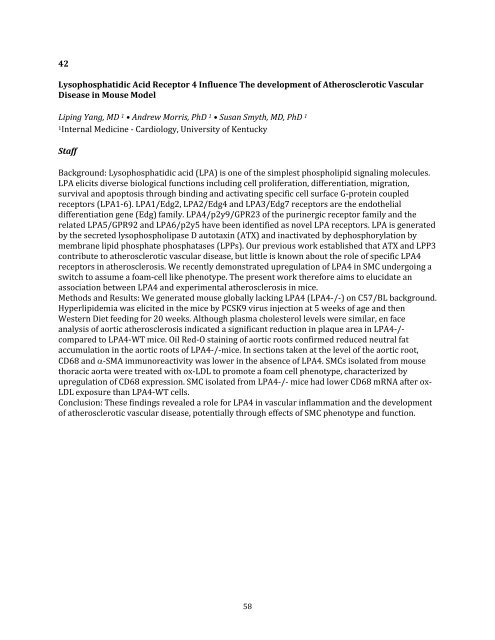2017 Cardiovascular Research Day Abstract Book
You also want an ePaper? Increase the reach of your titles
YUMPU automatically turns print PDFs into web optimized ePapers that Google loves.
42<br />
Lysophosphatidic Acid Receptor 4 Influence The development of Atherosclerotic Vascular<br />
Disease in Mouse Model<br />
Liping Yang, MD 1 • Andrew Morris, PhD 1 • Susan Smyth, MD, PhD 1<br />
1Internal Medicine - Cardiology, University of Kentucky<br />
Staff<br />
Background: Lysophosphatidic acid (LPA) is one of the simplest phospholipid signaling molecules.<br />
LPA elicits diverse biological functions including cell proliferation, differentiation, migration,<br />
survival and apoptosis through binding and activating specific cell surface G-protein coupled<br />
receptors (LPA1-6). LPA1/Edg2, LPA2/Edg4 and LPA3/Edg7 receptors are the endothelial<br />
differentiation gene (Edg) family. LPA4/p2y9/GPR23 of the purinergic receptor family and the<br />
related LPA5/GPR92 and LPA6/p2y5 have been identified as novel LPA receptors. LPA is generated<br />
by the secreted lysophospholipase D autotaxin (ATX) and inactivated by dephosphorylation by<br />
membrane lipid phosphate phosphatases (LPPs). Our previous work established that ATX and LPP3<br />
contribute to atherosclerotic vascular disease, but little is known about the role of specific LPA4<br />
receptors in atherosclerosis. We recently demonstrated upregulation of LPA4 in SMC undergoing a<br />
switch to assume a foam-cell like phenotype. The present work therefore aims to elucidate an<br />
association between LPA4 and experimental atherosclerosis in mice.<br />
Methods and Results: We generated mouse globally lacking LPA4 (LPA4-/-) on C57/BL background.<br />
Hyperlipidemia was elicited in the mice by PCSK9 virus injection at 5 weeks of age and then<br />
Western Diet feeding for 20 weeks. Although plasma cholesterol levels were similar, en face<br />
analysis of aortic atherosclerosis indicated a significant reduction in plaque area in LPA4-/-<br />
compared to LPA4-WT mice. Oil Red-O staining of aortic roots confirmed reduced neutral fat<br />
accumulation in the aortic roots of LPA4-/-mice. In sections taken at the level of the aortic root,<br />
CD68 and α-SMA immunoreactivity was lower in the absence of LPA4. SMCs isolated from mouse<br />
thoracic aorta were treated with ox-LDL to promote a foam cell phenotype, characterized by<br />
upregulation of CD68 expression. SMC isolated from LPA4-/- mice had lower CD68 mRNA after ox-<br />
LDL exposure than LPA4-WT cells.<br />
Conclusion: These findings revealed a role for LPA4 in vascular inflammation and the development<br />
of atherosclerotic vascular disease, potentially through effects of SMC phenotype and function.<br />
58


